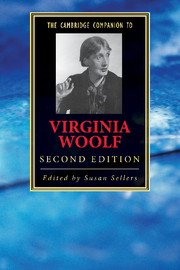Book contents
- Frontmatter
- 1 Bloomsbury
- 2 Virginia Woolf’s early novels: Finding a voice
- 3 From Mrs Dalloway to The Waves: New elegy and lyric experimentalism
- 4 The novels of the 1930s and the impact of history
- 5 Virginia Woolf’s essays
- 6 Virginia Woolf, modernism and modernity
- 7 The socio-political vision of the novels
- 8 Woolf’s feminism and feminism’s Woolf
- 9 Virginia Woolf and sexuality
- 10 Virginia Woolf, Empire and race
- 11 Virginia Woolf and visual culture
- 12 Virginia Woolf and the public sphere
- Guide to further reading
- Index
1 - Bloomsbury
Published online by Cambridge University Press: 28 July 2010
- Frontmatter
- 1 Bloomsbury
- 2 Virginia Woolf’s early novels: Finding a voice
- 3 From Mrs Dalloway to The Waves: New elegy and lyric experimentalism
- 4 The novels of the 1930s and the impact of history
- 5 Virginia Woolf’s essays
- 6 Virginia Woolf, modernism and modernity
- 7 The socio-political vision of the novels
- 8 Woolf’s feminism and feminism’s Woolf
- 9 Virginia Woolf and sexuality
- 10 Virginia Woolf, Empire and race
- 11 Virginia Woolf and visual culture
- 12 Virginia Woolf and the public sphere
- Guide to further reading
- Index
Summary
The entry on Virginia Woolf in the old Dictionary of National Biography, a piece by David Cecil (who married a daughter of the Bloomsbury Group), speaks of 'the shimmering felicities of her style' and concludes that in her work 'the English aesthetic movement brought forth its most exquisite flower'. In such light, where the language of biography trespasses upon eulogy and teeters floridly towards obituarese, we might recall how Woolf's father, Leslie Stephen, the DNB's founding editor, pursued a policy of 'No flowers by request' when briefing his contributors. Stephen died in 1904. The incumbents at the dictionary in Cecil's day were obviously more relaxed about floral arrangements. They let him get away with not just a flower (a Wildean lily?) but a whole bouquet. For what after all is or was the English aesthetic movement? To put the question is not to suggest that there are no lines of relation between the diverse stock of, say, John Ruskin, Walter Pater and Oscar Wilde, and that of a no less diverse Bloomsbury Group. Rather it is to ask, what is the nature of that relation? If it is at all important, how important is it in the cultural formation of Bloomsbury?
- Type
- Chapter
- Information
- The Cambridge Companion to Virginia Woolf , pp. 1 - 28Publisher: Cambridge University PressPrint publication year: 2010
- 2
- Cited by



